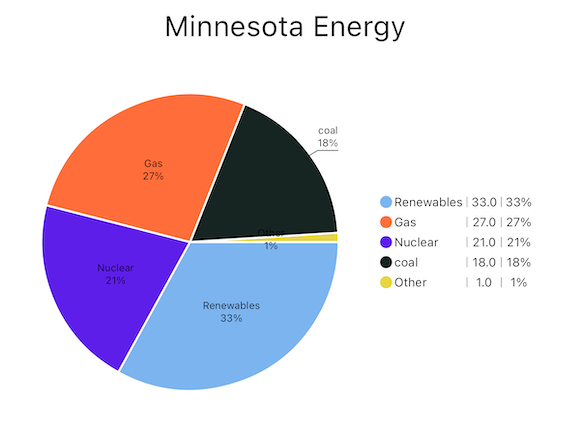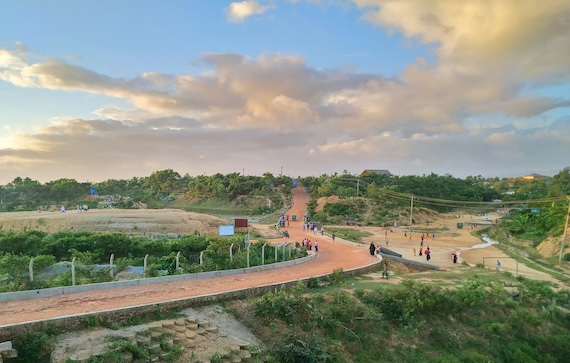
Tim Walz took Minnesota to 54% Clean Electricty and Annual Reductions of Carbon; Can he do it for the USA?
Ann Arbor (Informed Comment) – The Democratic National Convention on Wednesday evening introduce Tim Walz, the governor of Minnesota, to the American public. It was a touching scene, with the enthusiasm of Walz’s family on full display, and his own folksy demeanor and common sense, along with a wry sense of humor, clearly wowed the audience.
I hate to get wonky in the midst of this feel-good moment, but elections are about policy. Here I want to examine a specific policy, green energy and climate. Although Walz was not thought particularly good on green energy when he was in Congress, his record as governor of Minnesota has shown real successes in these regards. I went through Uni Nexis and distilled these items from Targeted New Service on his record, which seems to me impressive.
On September 16, 2019, Gov. Tim Walz announced clean car standards in Minnesota, according to Targeted News Service. He instructed his Administration to enforce a pair of clean vehicle regulations aimed at cutting down automobile emissions in the state. The low-emission vehicle (LEV) regulation mandated that car manufacturers offer passenger cars, trucks, and SUVs with reduced greenhouse gas emissions for the Minnesota market. Meanwhile, the zero-emission vehicle (ZEV) regulation compelled automakers to provide a greater number of vehicles with minimal or no tailpipe emissions for sale in the state, such as electric vehicles (EVs) and plug-in hybrids. Initial forecasts suggested that together, these two initiatives likely will have decreased yearly greenhouse gas emissions by two million tons by 2030. Walz remarked in this connection, slamming the pro-carbon then-President Trump “Climate change threatens the very things that make Minnesota a great place to live, from our magnificent 10,000 lakes to our farmable land and clean air. If Washington won’t lead on climate, Minnesota will. That is why we are taking bold action to reduce carbon emissions in a way that increases car options, protects public health, creates jobs, and saves Minnesotans money at the pump.”
On January 22, 2021, when Joe Biden had just come into the White House, Governor Tim Walz and Lieutenant Governor Peggy Flanagan unveiled a series of policy proposals aimed at achieving 100 percent clean electricity in Minnesota by 2040. These proposals expanded on Minnesota’s previous accomplishments in lowering reliance on fossil fuels and greater use of renewable energy to supply the state’s power needs. Walz said, “The time to fight climate change is now. Not only is clean energy the right and responsible choice for future generations, clean energy maximizes job creation and grows our economy, which is especially important as we work to recover from the COVID-19 pandemic. I am proud to announce a set of policy proposals that will lead Minnesota to 100% clean energy in the state’s electricity sector by 2040. Minnesotans have the ingenuity and innovation needed to power this future, and we are ready to pioneer the green energy economy.” (-Targeted News Service).
Note that 2040 is ten years before the Paris Climate Treaty’s deadline of 2050, so this was an ambitious climate plan.
On Jul 28, 2021 Targeted News Service reported that Walz and Lieutenant Governor Peggy Flanagan ceremonially affixed their signatures to the historic Energy Conservation and Optimization Act of 2021 (ECO Act). This legislation enhanced Minnesota’s energy-savings, diminished greenhouse gas emissions, and generated employment throughout the state. These jobs involved projects related to electricity, heating and cooling, ventilation, and insulation in residences and commercial establishments in Minnesota. Walz praised the bill for keeping Minnesota in the forefront of energy policy. The Act helped families improve the energy efficiency of their homes and expanded eligibility of low-income families for such aid. It created jobs in housing insulation, electrical wiring, ventilation and heating and cooling.
On Aug 12, 2021, a study was released by E2 (Environmental Entrepreneurs) and nonprofits Clean Energy Trust and Clean Energy Economy MN (CEEM) showing that in excess of 55,300 Minnesotans worked in “energy efficiency and clean energy” by the end of 2020. Walz observed of the bipartisan report, “By supporting the growth of clean energy jobs, we are not only boosting our economy, but also protecting our environment and Minnesota’s future. This report proves that we can have a clean future while creating jobs at the same time. Minnesota workers have the ingenuity and dedication needed to pioneer the green energy economy and bring us into the future.” (Targeted News Service.)
On August 18, 2022, Walz and Flanagan hailed the Biden Administration’s Inflation Reduction Act, which is actually green energy and climate legislation. Walz called it a “big win for Minnesota.” (Targeted News Service).
As of 2024, a third of Minnesota’s electricity now comes from wind, water, solar and biomass. The state added 600 megawatts of wind and solar this year.
Another 21% came from nuclear power, which is low-carbon, so 54%, a majority, of Minnesota’s electricity is now low-carbon. Coal-fired electricity has fallen dramatically to only 19%, with somewhat cleaner natural gas at 27%.
In just the past year, Minnesota’s emissions fell 10%. EV registrations, still limited, grew by 55% since last year.
These numbers are across the board better than those of the United States as a whole, which speaks well of Gov. Walz. It is to be hoped that he can bring his climate and green energy commitments to the national stage as vice president.

Notional, slightly inexact effort to depict the likely components of Minnesota electricity in summer 2024.








